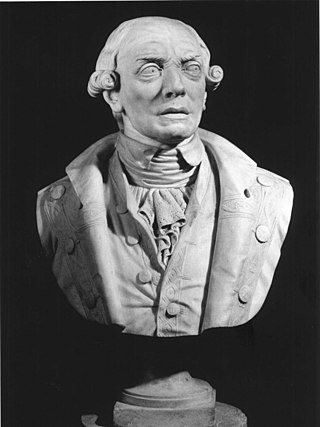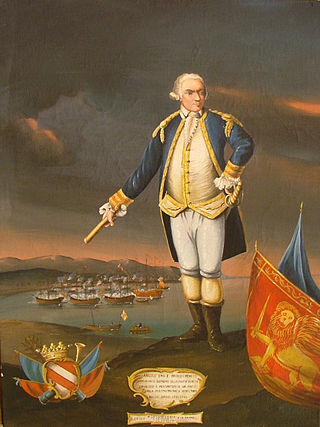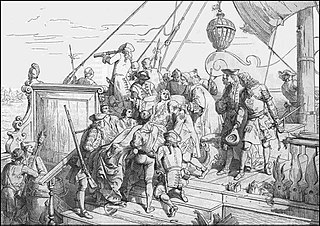Related Research Articles

The "seventy-four" was a type of two-decked sailing ship of the line, which nominally carried 74 guns. It was developed by the French navy in the 1740s, replacing earlier classes of 60- and 62-gun ships, as a larger complement to the recently-developed 64-gun ships. Impressed with the performance of several captured French seventy-fours, the British Royal Navy quickly adopted similar designs, classing them as third rates. The type then spread to the Spanish, Dutch, Danish and Russian navies.

Angelo Emo was a Venetian noble, administrator, and admiral. He is notable for his reforms of the Venetian navy and his naval campaigns, being regarded as the last great admiral of the Venetian Republic.

The Venetian navy was the navy of the Venetian Republic which played an important role in the history of the republic and the Mediterranean world. It was the premier navy in the Mediterranean Sea for many centuries between the medieval and early modern periods, providing Venice with control and influence over trade and politics far in excess of the republic's size and population. It was one of the first navies to mount gunpowder weapons aboard ships, and through an organised system of naval dockyards, armouries and chandlers was able to continually keep ships at sea and rapidly replace losses. The Venetian Arsenal was one of the greatest concentrations of industrial capacity prior to the Industrial Revolution and responsible for the bulk of the republic's naval power.

The Leon Trionfante class were a class of at least fourteen 70-gun third-rate ships of the line built by the Venetian Arsenale from 1716 to 1785, in four different series with minor changes in the ships' length. In 1797, when Venice fell to the French, Napoleon captured several ships of the class, still unfinished in the Arsenal: he chose one of them, forced the shipbuilders to have it completed and added it to his fleet en route for Egypt. After Campoformio, the remaining vessels were destroyed by the French to avoid their capture by the Austrian Empire.
Corona was a one-member ship of the line class, a 76-gun third rate. It was built in 1712 by the Venetian Arsenal, and was one of the bigger and better armed vessels of the Venetian Navy. Its guns were all made in bronze for prestige reasons. The ship, even if it was a well-made one, was not copied, and the Navy chose to skip to the cheaper Leon Trionfante class instead.

The Venetian bombardments of the Beylik of Tunis were a series of naval bombardments of the capital and various port cities of the Beylik of Tunis by the Venetian navy in order to force Bey Hammuda ibn Ali to resume the treaty that protected Venetian-flagged shipping from harassment by Barbary pirates. The campaign lasted from 1784 to 1786, with the Venetian navy under Angelo Emo bombarding the harbour towns of Tunisia. The conflict dragged on until 1792, but no major naval actions were undertaken after the winter of 1786/87.
Tommaso Condulmer was a Venetian naval officer and nobleman. After the death of Angelo Emo he took command of the Venetian navy, and held major responsibilities in the aborted defense of Venice against Napoleon's forces which eventually led to the fall of the Republic of Venice in 1797.
The San Lorenzo Zustinian class were a class of at least twenty-nine 70-gun third-rate ships of the line built by the Venetian Arsenale from 1691 to 1746, in three different series with minor changes in the ships' length. It was the most numerous class of ship of the line built in Venice, and the last to see active service in a war against the Ottoman Empire in 1718. All this class' ships were planned before 1720, and the vast majority was launched before the Peace of Passarowitz. The last four vessels were completed to 70% in 1720s, then stored in the roofed shipbuilding docks of the Arsenale to be finished and launched between 1739 and 1746, a solution that was widely used with the following Leon Trionfante class.
The Captain of the Gulf was a senior naval command of the Republic of Venice.

The Provveditore Generale da Mar was the most senior peacetime office in the Venetian navy and in charge of governing the Venetian overseas empire.

The Capitano Straordinario delle Navi was the senior wartime commander of the ships of the line of the navy of the Republic of Venice.

Andrea Pisani was a Venetian noble who served as Captain General of the Sea during the Seventh Ottoman–Venetian War.

Lodovico Flangini was a Venetian noble who served as Capitano Straordinario delle Navi during the Seventh Ottoman–Venetian War.
This is an alphabetical index of people, places, things, and concepts related to or originating from the Republic of Venice. Feel free to add more, and create missing pages.
The Giove Fulminante class were the first class of first-rate ships of the line built by the Venetian Arsenal, from 1666 to 1691, armed with 62 to 68 guns. The fifth ship of the class was extensively modified during construction and became the lead ship of the following San Lorenzo Zustinian class. The last ship of the class was retired in 1709.
Europa was a first-rank ship of the line of the Venetian navy, serving from 1739 to 1764.
Adria in Pace was a first-rank ship of the line of the Venetian navy, serving from 1739 to 1753.
San Carlo Borromeo was a first-rank ship of the line of the Venetian navy, serving from 1750 to 1768.

Jacopo or Giacomo Nani was an admiral and politician active during the last decades of the Republic of Venice.
Forza was a first-rank ship of the line of the Venetian navy, serving from 1774 to 1784, although it was originally laid down in 1719.
References
- 1 2 Ercole 2022, p. 10 (note 4).